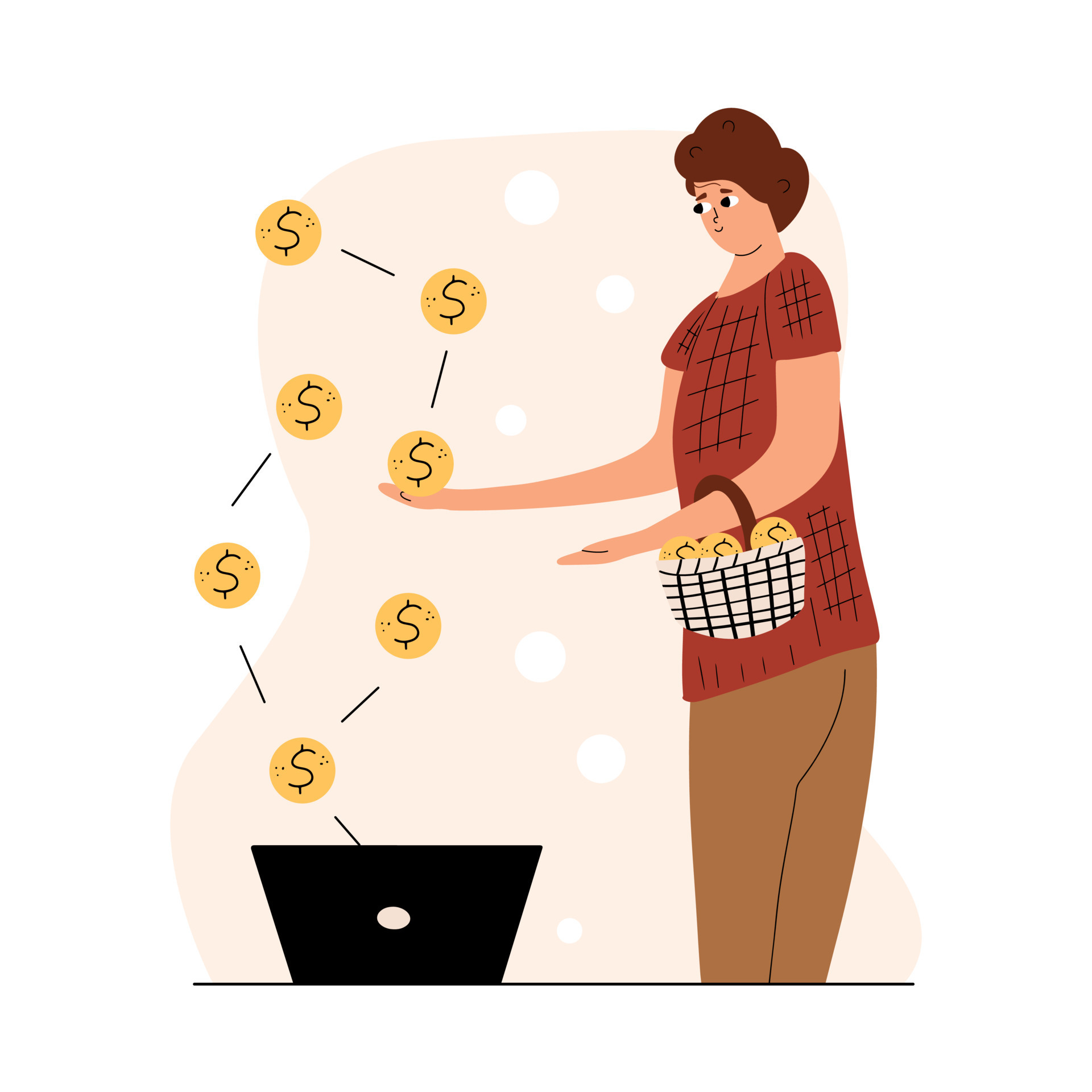Thinking about turning your art into a steady stream of income? Selling illustrations on Shutterstock might just be the perfect opportunity for you. It’s a platform where artists and designers can showcase their work to a global audience and earn royalties each time someone downloads their images. Whether you’re a seasoned illustrator or just starting out, Shutterstock provides a relatively straightforward way to make passive income from your creative talents. In this guide, we’ll walk through the essentials—from setting up your account to maximizing your earnings—so you can start turning your illustrations into a reliable revenue source.
Setting Up Your Shutterstock Contributor Account

Getting started on Shutterstock is simpler than you might think. The first step is creating a contributor account. Head over to the Shutterstock Contributor website and click on the “Sign Up” button. You’ll be prompted to fill in some basic information like your name, email address, and a secure password. Once you’ve registered, you’ll need to verify your email, so check your inbox for the confirmation link.
Next, you’ll be asked to provide some additional details, including your full name, country of residence, and tax information. This is important because your earnings will be subject to taxes, and Shutterstock needs this info to process your payments accurately. Make sure to have your tax ID or social security number ready if required.
After completing your profile, you’ll be directed to the contributor dashboard. This is your control center where you’ll upload new illustrations, track your sales, and manage your account settings. Before diving into uploading, take some time to familiarize yourself with Shutterstock’s content guidelines. They want to ensure that all images meet quality standards and are appropriately licensed. Your illustrations should be high resolution, well-lit, and free of watermarks or branding.
When your account setup is complete, you’ll need to agree to Shutterstock’s contributor terms. Once accepted, you’ll be able to start uploading your illustrations. Remember, the more high-quality images you add, the more opportunities you’ll have to earn royalties. So, set up your account carefully, adhere to guidelines, and start sharing your artwork with the world!
Preparing Your Illustrations for Upload

Before you click that upload button, it’s crucial to make sure your illustrations are in the best shape possible. Quality and presentation can make all the difference when it comes to getting noticed and earning on Shutterstock. So, let’s talk about how to prepare your artwork for a smooth upload process and maximum impact.
First off, ensure your illustrations are high-resolution. Shutterstock recommends images at minimum 4 megapixels (for example, 2400 x 1600 pixels). Higher resolution images look more professional and are more appealing to buyers. If you’re working with vector files, make sure they are clean and scalable without any artifacts or errors.
Next, consider the file format. Shutterstock prefers JPEG for raster images and AI, EPS, or SVG for vectors. Save your JPEGs in sRGB color space—this is the standard for web and digital use, ensuring your colors look consistent across screens.
It’s also a good idea to review your illustrations for any imperfections. Check for stray marks, inconsistent lines, or color issues. Use image editing software like Photoshop or Illustrator to make final tweaks—adjust contrast, brightness, and saturation if needed. Removing any watermarks or signatures is essential unless they are part of the design and intended as a watermark.
Another tip: include a variety of images if you’re uploading a series. This can mean different angles, color schemes, or versions of your illustration. It helps your portfolio look diverse and increases your chances of matching buyer needs.
Don’t forget to prepare a preview image. Shutterstock often automatically creates a thumbnail, but if you want to showcase your work effectively, consider uploading a clean, well-lit, and visually appealing preview. This can help your illustrations stand out when browsing.
Finally, organize your files before uploading. Use clear naming conventions—something like flower_illustration_v1.jpg—so you can easily identify and manage your entries later. Good preparation saves you time and reduces errors during the upload process.
Uploading and Tagging Your Illustrations Effectively
Now that your illustrations are polished and ready, it’s time to upload them to Shutterstock. But upload isn’t just about clicking a button—effective uploading and tagging are key to getting your work seen by the right people and earning passive income.
Start by logging into your Shutterstock Contributor account and heading to the upload section. You can upload multiple images at once, which is a huge time-saver. As you upload, fill out the necessary details for each illustration, but don’t skip the most important part—tags and descriptions.
Tags are like keywords that help buyers find your artwork. Think about what someone might search for if they wanted an illustration like yours. Use relevant, specific tags—avoid generic or overly broad terms. For example, if your illustration is of a “happy dog,” include tags like dog, puppy, happy, pet, animal, canine, joyful, pet illustration.
Use all available tag slots to maximize discoverability. Shutterstock recommends at least 15 tags per image, but more can be better—just make sure they are relevant. Incorporate synonyms and related terms to cover different search intents.
Next, craft a compelling description. This isn’t just for SEO; it helps buyers understand what they’re getting. Be clear and concise, highlighting key elements of your illustration. For example: “A colorful vector illustration of a playful puppy sitting on grass, perfect for pet-related projects and children’s books.”
Consider the following tips for effective uploading and tagging:
- Use descriptive keywords: Be specific about colors, objects, and mood.
- Include popular search terms: Think about trending topics or styles.
- Avoid spammy tags: Don’t stuff irrelevant keywords; it can hurt your ranking.
- Update tags regularly: As trends change, revisit your tags to keep your images discoverable.
Finally, double-check everything before submitting. Once uploaded, your illustrations will go through Shutterstock’s review process, which typically takes a few days. If approved, they’ll be live and ready to generate passive income whenever someone purchases or licenses your art. Keep uploading consistently and refining your tagging strategy—over time, your portfolio will grow and start earning more passively!
Optimizing Your Portfolio for Better Visibility
Alright, so you’ve uploaded some stunning illustrations to Shutterstock—great job! But here’s the thing: just uploading isn’t enough. To really make your illustrations shine and get noticed by buyers, you need to optimize your portfolio. Think of it as setting up a shop window that draws people in. The more appealing and discoverable your portfolio, the more traffic and sales you’ll generate.
First off, focus on quality over quantity. It’s tempting to upload everything you create, but Shutterstock’s reviewers look for images that are polished and professional. Make sure each illustration is high-resolution, well-composed, and free of any distracting elements or errors.
Next, pay attention to keywords and descriptions. When uploading, you’ll add tags that help people find your work. Use relevant, specific keywords related to your illustration. Think about what a buyer might search for—colors, themes, styles, or concepts. For example, instead of just “flower,” use “pink cherry blossom illustration” or “watercolor floral design.” The more accurate your tags, the higher your chances of appearing in search results.
Here are some tips for better visibility:
- Use diverse keywords: Don’t rely on generic tags. Include related terms and synonyms.
- Update your portfolio regularly: Fresh content signals activity, which can boost your visibility.
- Group similar images into collections: This can encourage viewers to explore your work more deeply.
- Engage with the community: Participate in forums or comment on other artists’ portfolios to increase your presence.
Another powerful way to stand out is to tailor your illustrations to trending topics or seasonal themes. Keep an eye on popular search terms and create images that fit current demand. For example, during the holidays, holiday-themed illustrations tend to get more attention.
Lastly, consider creating a cohesive style or theme in your portfolio. Buyers often look for consistent work, especially if they’re sourcing illustrations for a brand or project. A recognizable style can turn browsers into repeat customers.
Understanding Shutterstock’s Licensing and Revenue Structure
Before diving deep into selling your illustrations, it’s crucial to understand how Shutterstock’s licensing and revenue system works. This knowledge will help you set realistic expectations and optimize your earnings.
Shutterstock offers two main types of licenses:
- Standard License: This covers most common uses, like websites, presentations, social media, and print up to a certain size. It’s suitable for small to medium projects.
- Enhanced License: Designed for larger-scale uses, such as billboards, merchandise, or products for resale. It allows for broader distribution and higher print runs.
When a customer downloads your illustration, you earn royalties based on your contributor level and the type of license purchased. Shutterstock’s payout system is primarily per download. The more popular your images are, the more you earn.
Here’s a quick overview of the revenue structure:
| Contributor Level | Royalty Rate per Download | Additional Benefits |
|---|---|---|
| Standard | Starting at around 15-30% | Access to exclusive contests and opportunities |
| Elite | Higher percentage, up to 40% | More featured placements and priority support |
It’s important to note that earnings accumulate over time. Popular illustrations continue to generate passive income as long as they are downloaded. Also, Shutterstock periodically updates its payout rates and policies, so staying informed through their contributor dashboard or newsletter is a good idea.
To maximize your earnings, focus on creating high-demand, versatile illustrations and optimize your tags and descriptions to increase downloads. Remember, the more your work is viewed and downloaded, the more passive income you can generate!
Promoting Your Illustrations to Increase Sales
Once you’ve uploaded your fantastic illustrations to Shutterstock, the next step is making sure they get seen by the right people. Promoting your work might sound a bit intimidating at first, but with a few simple strategies, you can significantly boost your visibility and sales.
Share on Social Media – Platforms like Instagram, Twitter, and Pinterest are perfect for showcasing your artwork. Create dedicated accounts or posts highlighting your best illustrations, and include direct links to your Shutterstock portfolio. Use relevant hashtags to reach a wider audience, such as illustrationart, digitalart, or specific keywords related to your niche.
Engage with Online Communities – Join forums, Facebook groups, or Reddit communities centered around illustration and design. Participate in discussions, share your work when appropriate, and build genuine relationships. Sometimes, community members might be interested in purchasing or sharing your work, increasing your exposure organically.
Leverage Your Website or Blog – If you have a personal website or blog, feature your Shutterstock illustrations there. Write about your creative process, tools you use, or stories behind each piece. This not only drives traffic but also helps establish your authority as an illustrator, making potential clients more confident in purchasing your work.
Collaborate with Other Creators – Partnering with bloggers, designers, or influencers can open up new audiences. Offer to create custom illustrations for their projects, or ask if they’d be willing to share your work. Cross-promotion can lead to more downloads and sales.
Optimize Your Shutterstock Profile and Keywords – Make sure your illustrations are correctly tagged with relevant keywords. Well-optimized keywords help your images show up in search results, increasing the chance of sales. Think about what your target buyers might search for and include those terms.
Remember, promoting your illustrations is an ongoing process. The more effort you put into sharing and engaging, the more eyes will see your work—and that means more opportunities to generate passive income from Shutterstock.
Tips for Consistently Creating and Uploading New Content
In the world of stock illustration, consistency is key. Regularly adding fresh, high-quality content keeps your portfolio active and appealing to Shutterstock’s algorithm, which favors active contributors. Plus, it increases your chances of making sales since more images mean more opportunities for buyers to discover your work.
Set a Realistic Schedule – Whether you aim to upload one new illustration per week or a few per month, create a schedule that fits your lifestyle. Consistency beats perfection—it’s better to upload regularly at a manageable pace than to burn out trying to produce too much at once.
Plan Your Content in Advance – Keep a content calendar or idea list. Think about upcoming trends, seasons, or events that you can create illustrations around. For example, holiday-themed images, trending topics, or popular design styles. Planning ahead makes the creation process smoother and less stressful.
Diversify Your Creations – Don’t just stick to one style or subject. Explore different themes, color palettes, and techniques. This variety not only attracts a broader audience but also keeps your creative process exciting and fresh.
Batch Your Work – Create multiple illustrations in one sitting. Batch processing helps you stay efficient and maintain a steady flow of uploads. For example, sketch several concepts, then move on to coloring and detailing all at once.
Stay Inspired and Keep Learning – Follow other artists, attend webinars, or take online courses to hone your skills. The more you learn, the more diverse and appealing your illustrations will become. Inspiration keeps your creative juices flowing and helps you stay motivated to produce new content.
Remember, the key to building a passive income stream through Shutterstock is not just about uploading a few images but maintaining a steady pipeline of new, high-quality work. Keep creating, stay organized, and watch your portfolio grow—and with it, your potential for earning passively from your illustrations.
Tracking Your Earnings and Analyzing Performance
So, you’ve started uploading your fantastic illustrations to Shutterstock — great! But now what? The key to turning your creative efforts into real income is understanding how your work is performing and making data-driven decisions. Luckily, Shutterstock provides a handy dashboard that helps you track your earnings and analyze which images are resonating most with buyers.
First off, regularly check your Contributor Dashboard. Here, you’ll find essential metrics like:
- Download Count: How many times each illustration has been downloaded.
- Royalty Earnings: The income generated from each download.
- Monthly and Yearly Reports: Summaries that help you spot trends over time.
To really optimize your portfolio, take note of which images are performing well. Are certain styles, themes, or color schemes getting more downloads? If you notice that, say, minimalist vector illustrations are popular, consider creating more in that niche.
Additionally, Shutterstock offers search analytics— insights into how buyers are searching for images. This can reveal keywords that are trending or underrepresented, giving you ideas for new illustrations. Use this information to:
- Refine your keyword strategy, making sure your images are discoverable.
- Identify popular themes and adapt your upcoming projects accordingly.
- Understand seasonal or current event trends that could boost your sales.
Remember, consistency is key. Track your earnings monthly to see what’s improving and what might need a tweak. If a certain set of illustrations isn’t selling, consider revisiting your approach—maybe tweak the style or update the keywords. Over time, this analytical approach helps you fine-tune your portfolio for better passive income streams.
Additional Resources for Shutterstock Contributors
Want to level up your Shutterstock game? Luckily, there are plenty of resources out there designed to help you grow as a contributor and boost your passive income. Here’s a list of some of the most helpful tools and communities to consider:
Official Shutterstock Resources
- Contributor Blog: Regular updates, tips, and success stories from other contributors.
- Help Center: Detailed guides on uploading, copyright, keywords, and more.
- Webinars and Tutorials: Free sessions that cover best practices for creating marketable illustrations.
Online Communities and Forums
- Reddit: Subreddits like r/Shutterstock and r/Illustration provide peer support, feedback, and tips.
- Facebook Groups: Join groups dedicated to stock contributors to share experiences and strategies.
- DeviantArt & Behance: Platforms to showcase your work, gather inspiration, and connect with other artists.
Educational Platforms and Courses
- Udemy & Skillshare: Courses on digital illustration, keyword optimization, and marketplace selling.
- LinkedIn Learning: Professional courses on branding, marketing, and design trends.
Tools to Improve Your Workflow
- Keyword Research Tools: Use tools like Keyword Tool or Google Trends to find trending tags.
- Design Software: Adobe Illustrator, Photoshop, or free alternatives like Inkscape and GIMP to craft high-quality images.
- Analytics & Tracking: Tools like Google Analytics for your portfolio website or data export features from Shutterstock to monitor performance.
Staying informed and connected is vital for ongoing success. By leveraging these resources, you can improve your skills, stay current with market trends, and build a supportive community that motivates you along the way. Remember, the more you invest in learning and community engagement, the better your chances of turning your illustrations into a steady stream of passive income!


